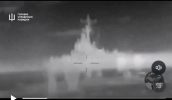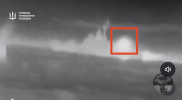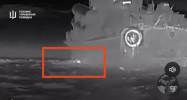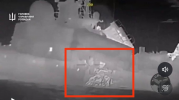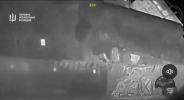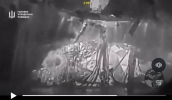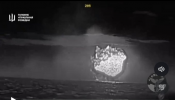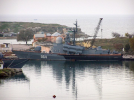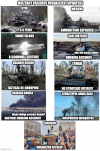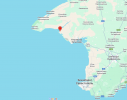https://www.forbes.com/sites/davidh...n-of-russias-deadliest-drone/?sh=6537c83f7355
How One Blast Shut Down Production Of Russia’s Deadliest Drone
David Hambling
Senior Contributor
I'm a South London-based technology journalist, consultant and author
Feb 1, 2024, 06:42am EST
ZALA CEO Alexandr Zakharov tours a new production facility with hundreds of Lancets under production on a video aired in July. RUSSIAN STATE MEDIA
The Lancet has been one of Russia’s most effective weapons in this war, a small kamikaze drone which can find and destroy targets from 40 miles away with deadly precision. Lancets knock
out Leopard tanks, artillery and
even parked aircraft. Valerii Zaluzhnyi, Ukraine’s Commander-in-Chief, singled the Lancet out as a specific problem
in his recent paper on the current military situation. Only a few appeared at first, dozens per month, but in July 2023 numbers were set to soar.
Instead, something interrupted the supply.
That month Russian news media showed a video of Lancet makers Zala Aero, featuring their flamboyant CEO Aleksandr Zakharov
CEO touring a giant new production facility in a converted shopping mall on a Segway. The video showed racks of hundreds of Lancets, and one article suggested that production could
increase by a factor of fifty. This looked like bad news for Ukraine. But instead of surging, Lancet strikes dropped off markedly. There was initially no clue as to what had happened.
Information from
Molfar, a Ukrainian OSINT group looking at sabotage operations in Russia, suggests that the cause may have been a well-targeted strike by Ukrainian forces.
The ZOMZ Explosion
On August 9th, Russian
state media source TASS reported a massive explosion on the site of the Zagorsk Optical-Mechanical Plant (aka ZOMZ) in Sergiyev Posad near Moscow. They described the facility as making optical and optoelectronic devices for law enforcement, industry and healthcare. The company, established in 1935, is well known in Russia for
high-quality binoculars and opera glasses, and according
to ZOMZ website they also make medical equipment for diagnosing eye conditions as well as X-ray amplifiers.
The damage was considerable. Thirty people were taken to hospital, four buildings close to the center of the explosion were severely damaged and windows were blown out over a wide area. The damage extended to part of the local university, two schools, a sports complex and a store as well as thirty-eight apartments and four cars.
While some witnesses claimed ZOMZ was hit by a Ukrainian drone, these were discounted and TASS stated that “according to preliminary data, the cause of the explosion was not a drone.”
Fire from unknown cause damaged the site in June 2022, but this was on a different scale. The explosion was blamed on a warehouse used by fireworks company
Piro Ross.
A Suitable Scapegoat?
Piro had experience safety issues before. In 2019, an
accident at a fireworks display in Minsk (Belarus) left one spectator dead and ten injured. Responsibility was traced to Piro Ross, and two of its employees
were arrested.
Piro Ross is the main supplier of fireworks for the Russian Ministry of Defense, providing pyrotechnics for Moscow’s lavish
850th anniversary celebration in 1997 and many other events. However, according to Russian
state news source Iszvestia the company was fined 23 million rubles ($250k) for late deliveries to the Ministry of Defence, and three further claims were under consideration when the company declared bankruptcy in March 2023.
Piro Ross CEO Sergei Chankaev was arrested, but
denies that the explosion was anything to do with his company. He says that there were no explosive materials in the warehouse, and the explosion had in fact originated from a different building.
Molfar found comments from witnesses on discussion boards suggesting that a drone struck ZOMZ immediately before the explosion.
“Considering the Russian practice of concealing information about attacks on Russian military facilities, it can be assumed that the explosion in the premises of the Zagorsky plant was a planned action by the Ukrainian side,” a Molfar spokesman told Forbes.
The explosion was larger than could be accounted for a by a small drone, but targeting explosive material on the site – ‘bringing the detonator’ – may have done it.
Precision Targeting
Why would Ukraine target a plant producing opera glasses? It turns out that ZOMZ also produces binoculars and rifle scopes for the army. There have been hints of a deeper involvement, for example government documents revealed a
small ($700k) contract with ZOMZ related to Russia’s next-gen Messenger bomber – presumably optical devices.
Immediately after the ZOMZ explosion,
Ukrainian analyst Dmitro Snegirev told the news outlet Focus that the site was likely associated with producing components, presumably camera lenses or other optics, for the KUB and Lancet drones made by ZALA Aerospace. This would make sense given the proven Messenger contract, but there is no obvious connection between ZALA and ZOMS.
I asked Snegirev about his source of this information.
“Our special services. Without specifying. But it’s not GUR [Ukraine’s Main Directorate of Intelligence],” he told me.
There is no proven connection between ZOMZ and ZALA. But the explosion appears to have had an effect.
Supplies of Lancet kamikaze drones fell of sharply after the ZOMZ explosion. AUTHOR
Breaking The Supply Chain
The Lancet was unveiled in 2019 and deployed to Syria in 2021, but was slow to appear in the Ukraine conflict and not seen until July 2022. Russian military analysis site LostArmour has recorded
every single Lancet strike video shared on social media. This is likely to be a fraction of the total. One Ukrainian source puts the success rate of the Lancet at
approximately 30%, suggesting that there are a couple of failures or shootdowns for each of the strike videos seen.
LostArmour numbers show a rise and fall in Lancet strikes: from roughly 25 per month at the start of 2023, to almost 50 in March and April, rising to a peak of 135 in July. The number in August was similar at 126, but since then, rather than surging Lancet numbers sagged. September and October were in the 50s, a rally to 89 in November before falling back to 59 in December.
Rather than soaring Lancet production was slashed. Something happened in August which prevented ZALA from turning Lancet bodied into finished products.
The Lancet is, notoriously,
filled with imported components, including the engine and flight electronics. The only items ZALA specifically claim to make themselves are
the airframe, power supply and the camera. The explosion at ZOMZ may have interrupted the supply of cameras.
Another indirect confirmation that Lancet production was curtailed came from Russia’s Dense Minister Alexei Krivoruchko, who said that Russian drone production in 2023
amounted to 3,500 units in total.
Samual Bendett, an expert on Russian drone production and adviser to the CNA and CNAS
says this total likely includes Orlan and ZALA reconnaissance drones as well as Lancets and large military multicopters. If two thirds of the production was comparatively cheap Lancets rather than the other more expensive types, that would be about 2,300 Lancets. This fits extremely well with the 779 posted Lancet videos in 2023, assuming two misses for every hit.
Getting ready to launch a Lancet kamikaze drone
RUSSIAN MINISTRY OF DEFENSE
Drone Versus Drone
Lancet production is rising again, and the figure for January was 139 – higher than before the disruption. But the slowdown after August suggests that ZALA’s new factory cannot make drones without specific components. It may not take drone strikes to stop them. Efforts to impose and enforce sanctions could prevent Russia from acquiring the necessary electronics on the international market.
Russia is seeking to increase drone production on all fronts. In particular it is now
making Shahed drones itself rather than importing them from Iran and aims to produce thousands rather than hundreds per month.
Ukraine is beefing up its air defence to counter increasing numbers of Shahed drones
now made in Russia, and asking for more help from its allies.
Perhaps the best solution is to tackle the problem ‘left of launch’ by stopping Russia from building drones. Ukraine has the capacity to carry out large numbers of long-range drone strikes and has been successfully
hitting Russian oil and gas facilities. Perhaps Russia’s drone production facilities – Molfar have
located many of them in former shopping malls – should be on the target list. It is 2024 and drone versus drone warfare is becoming a strategic issue.
-
Follow me on
Twitter. Check out my
website or some of my other work
here.
David Hambling
Author of 'Swarm Troopers: How small drones will conquer the world,' following cutting-edge military technology in general and robotic systems in particular. New time-travel adventure 'City of Sorcerers' out now in paperback and Kindle.



